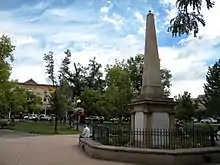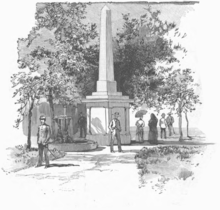Soldiers' Monument (Santa Fe, New Mexico)
The Soldiers' Monument is a controversial memorial monument at the center of the Santa Fe Plaza. It was erected as a 33 feet (10 m) stone obelisk and plinth in 1868.
.jpg.webp) | |
| Coordinates | 35°41′14.7474″N 105°56′18.6714″W |
|---|---|
| Location | Santa Fe Plaza, New Mexico |
| Type | obelisk and plinth with engraved text |
| Material | stone |
| Height | 33 feet (10 m) |
| Dedicated date | 1868 |
| Dedicated to | U.S. Soldiers who battled with Native Americans |
| Dismantled date | October 12, 2020 |
The square plinth includes four plaques which memorialized Union soldiers who died as part of the New Mexico Territory's participation in the American Civil War. The monument also referred to US soldiers who died fighting "savage Indians". The word "savage" was chiseled-off by an anonymous activist in 1974. On October 12, 2020, on Indigenous Peoples Day (Columbus Day), the plaque was further damaged by protesters.
Environs

The monument site is at the crux of several paths through the plaza and is surrounded by an iron fence and banco seating.
An interpretive plaque nearby explains the context:[1]
Monument texts reflect the character of the times in which they are written and the temper of those who wrote them. This monument was dedicated in 1868 near the close of a period of intense strife which pitted northerner against southerner, Indian against white, Indian against Indian. Thus, we see on this monument, as in other records, the use of such terms as ‘savage’ and ‘rebel’. Attitudes change and prejudices hopefully dissolve.
Structure


The monument consists of a 33-foot tall stone obelisk with four engraved marble plaques on the stone base commemorating U.S. soldiers who died in battles in New Mexico. It is located in the central area of the Santa Fe Plaza in downtown Santa Fe.[2]
Inscriptions
Written on the four sides of the cardinal directions of the plinth:
TO THE HEROES OF THE FEDERAL ARMY WHO FELL AT THE BATTLE OF VALVERDE, FOUGHT WITH THE REBELS FEBUARY 21, 1862
TO THE HEROES WHO HAVE FALLEN IN THE VARIOUS BATTLES WITH [ lacuna ] INDIANS IN THE TERRITORY OF NEW MEXICO
TO THE HEROES OF THE FEDERAL ARMY WHO FELL AT THE BATTLES OF CANON DEL APACHE AND PIGEON'S RANCH (LA GLORIETA) FOUGHT WITH THE REBELS MARCH 28, 1863 AND TO THOSE WHO FELL AT THE BATTLE FOUGHT WITH THE REBELS AT PERALTA APRIL 15, 1862.
ERECTED BY THE PEOPLE OF NEW MEXICO THROUGH THEIR LEGISLATURES OF 1866 - 7 - 8. MAY THE UNION BE PERPETUAL.
as transcribed from the monument, January 2018 (the lacuna refers to where the word "SAVAGE" was chiseled off in 1974). The Battle of Cañon del Apache mentioned refers to a phase of the Battle of Glorieta Pass, March 26–28, 1862. Note that February 21 is misspelled as "FEBUARY 21" .
Obelisk
Four stone components originally (1860s to 2020) including pyramidal cap.
Installation
Like other similarly-named monuments (see Soldier's Monument), it was erected in the aftermath of the American Civil War.[3] The inscription makes reference to the New Mexico Territorial Legislature, precursor to the post-statehood New Mexico Legislature, as being instrumental in the planning of the monument.
Controversy
.jpg.webp)
The monument has been described as racist [4] due to the derogarory references to indigenous inhabitants of the area then known as New Mexico Territory and now known as New Mexico [3] There have been calls beginning (at latest) during the 1950s [5] to remove or replace it, including by the then-president of the Santa Fe chapter of the NAACP in 2000, Wanda Ross Padilla.[1] City management was hesitant to make changes because the plaza received federal aid [6] as a National Historic Landmark in the 1960s and 1970s; however, the tip of the obelisk was removed by crane in the midst of the 2020 protests with concern about the stability of the upper sections cited as a safety motivation.
Chiseling
In August 1974, a young man wearing a hard hat walked into the plaza and chiseled out the word "savage" from the monument. [7] His identity has never been confirmed, although a woman claims it was her father.[8]
Subsequently various unauthorised alterations have been made to the obelisk, including the markering of 'courageous' in 2014 over the area where 'savage' had been previously chiseled, and in 2020 further blunt damage to the side of the obelisk previously chiseled along with spray-painting over other parts.
Toppling
On October 12, 2020 (Columbus Day or Indigenous Peoples' Day), protesters who had been at the Plaza since the previous day toppled the obelisk portion using ropes. Some arrests were made immediately prior to the toppling, although it is not clear if they resulted in immediate bookings; some injuries have been reported. [9] [10] [11]
| External video | |
|---|---|
Response
The following Sunday, the Santa Fe New Mexican published the usual weekly combined op-ed/letters to the editor/editorial page section, but this one was dedicated to the toppling of the obelisk; notable New Mexicans opined, including cartoonist Ricardo Caté[12] and authors Hampton Sides[13] and Allen Steele.[14]
References
- Mitchell, Don; Staeheli, Lynn A. (2005). "Turning Social Relations into Space: Property, Law and the Plaza of Santa Fe, New Mexico". Landscape Research. 30 (3): 361–378. doi:10.1080/01426390500165435. Retrieved 13 October 2020.
- "Plaza and Soldier's Monument Santa Fe, New Mexico". New Mexico Santa Fe Trail Scenic Byways. Retrieved 13 October 2020.
- Nelson, Megan Kate (10 July 2020). "Americans Need to Know the Hard Truth About Union Monuments in the West". The Atlantic. Retrieved 13 October 2020.
- Chacón, Daniel J. (19 August 2017). "Monuments to history — or oppression?". Santa Fe New Mexican. Retrieved 13 October 2020.
- Wilson, C. (1997);The Myth of Santa Fe: Creating a Modern Regional Tradition (Albuquerque, NM:University of New Mexico Press)
- Terrell, Steve (August 9, 2000). "City councilor agrees wording on monument is objectionable". Santa Fe New Mexican.
- Steinberg, Dave (10 August 1974). "Police Search for Vandal of Monument in Santa Fe". Albuquerque Journal. Archived from the original on 11 August 2020. Retrieved 13 October 2020.
- https://sfreporter.com/news/2020/06/18/a-long-time-coming
- Last, T.S.n (12 October 2020). "Native American activists tear down Santa Fe obelisk". Albuquerque Journal. Retrieved 12 October 2020.
- Mullan, Dillon (12 October 2020). "Protesters tear down Plaza obelisk". Santa Fe New Mexican. Retrieved 12 October 2020.
- Attanasio, Cedar; Fonseca, Felicia (12 October 2020). "Protesters topple monument in Santa Fe Plaza, part of Indigenous Peoples Day demonstration". Las Cruces Sun News. Retrieved 12 October 2020.
- https://santafenewmexican.com/article_8fe2b594-0ff6-11eb-a449-0b38c96536cf.html
- https://santafenewmexican.com/article_f99a584e-0fd7-11eb-9bfc-47ccb36feba2.html
- https://santafenewmexican.com/article_869915c8-0e9d-11eb-ac42-1f522c79c30a.html